Politics
What’s Behind the Museum of Modern Art’s Bitter Battle with Its Own Workers?
MoMA workers call its healthcare proposals a “slap in the face.”
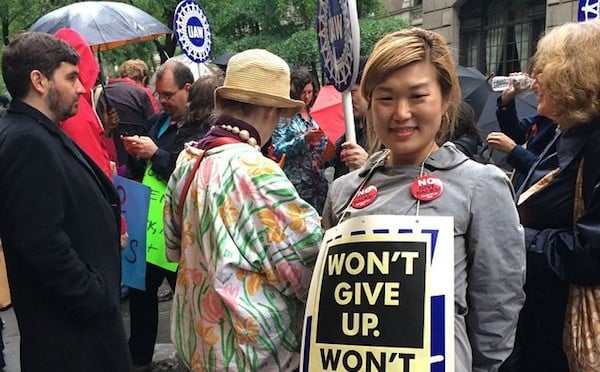
MoMA workers call its healthcare proposals a “slap in the face.”

Ben Davis

“We! Are! MoMA!” was the cry heard over and over last night outside the museum’s swanky annual Party in the Garden event, as 100 or more MoMA staff members massed outside the 53rd and 54th street entrances of the behemoth museum. The ruckus was the sound of simmering labor tensions erupting into the open as the museum negotiates terms with UAW Local 2110, which represents its professional staff.
In the lead up to the picket, I spoke to Local 2110 shop steward Danny Fermon about the issues faced by MoMA staff, and the negotiations that have led to the current protest.
BEN DAVIS: Who exactly do you represent?
DANNY FERMON: We are a unit within Local 2110 of the UAW and we comprise 280 people. We run the gamut on wages, from $30,000 at the low end, all the way up to closer to $80,000. Those are minimums, of course—it depends on how long you have been here.
We cover all the book stores, all the lobby staff, all the curatorial departments—that’s four or five curatorial departments—all the librarians, all the archivists, all the accountants, all the people in development, people in merchandising and retail. And it goes on: We cover special events, conservation, and so forth.
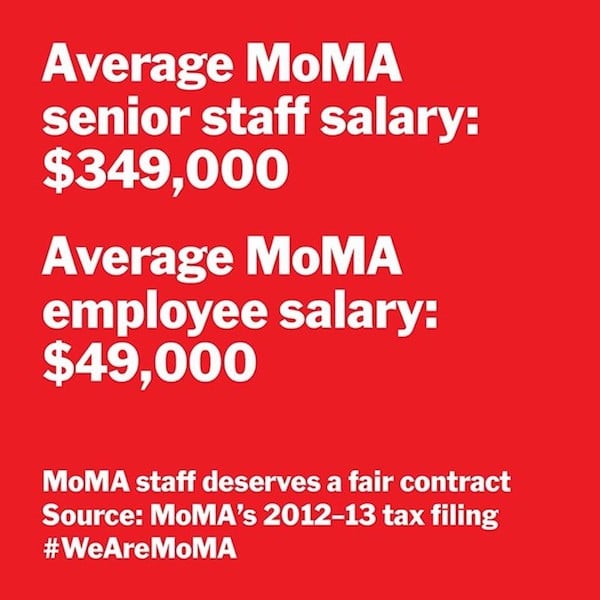
Meme from Local 2110’s #WeAreMoMA campaign
Most of the workers at MoMA?
The technical, office, and professional workers. We are a white-collar local of UAW [United Auto Workers].
What are the issues on the table?
The biggest issue is healthcare. We wanted an improvement on what we had, and they came back with what winds up being a slap in the face. Actually, “slap in the face” would be an understatement.
Right now, someone with single coverage pays nothing to their monthly premium. The museum pays the full premium, which is $700 a month. Now, they want us to begin paying towards the premium.
Employees who have family coverage, they currently pay 10 percent of the difference between the family coverage, which is $2,000 a month, and the $700 a month. With the new contract, the museum wants those employees to pay a whole lot more. It’s true that they are tweaking it and trying to get us to accept the proposal—but as it stands, it’s still a whole lot more.
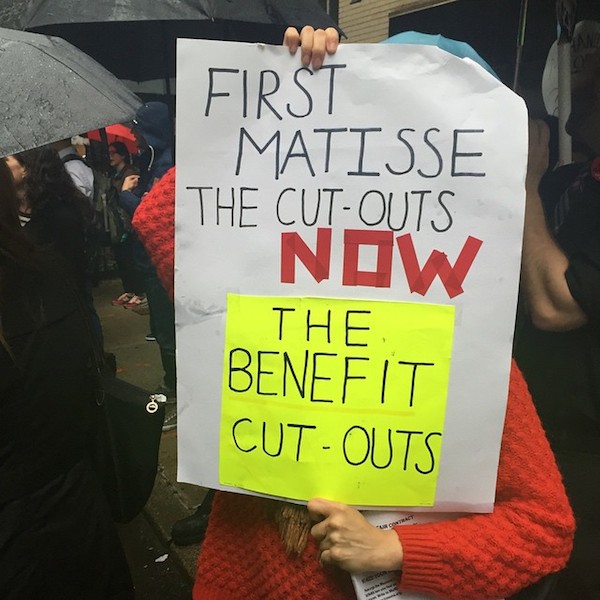
A protest sign at MoMA
Photo: @tatsmarooh Instagram
The other half is the plan design. They want us to pay coinsurance for hospitalization and any large major medical circumstances, 15 percent of the price plus a deductible. And they’re raising all the copays on top of that.
So you’re going to have premium charges now on a monthly basis, even if you never use a doctor, and then if you suddenly need to have, say, an MRI, you’re going to have to pay a huge chunk, depending on your salary.
They do try to show that they are sensitive and understanding, making the deductibles lower for the lower-paid employees and higher for the higher-paid employees. But the truth is, even the higher-paid employees are not well-paid for living in New York, so it’s kind of ridiculous.
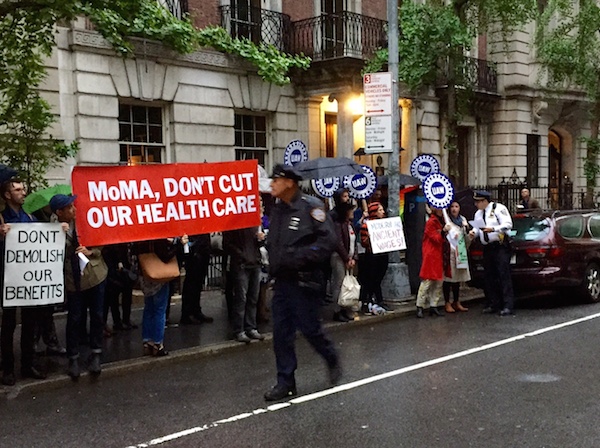
Police negotiate with protesting MoMA workers
Photo: Ben Davis
Have they offered anything to compensate for the changes?
They’re planning on having what are called “Health Reimbursement Accounts,” which could help. They’re modest, but they could help. It’s sort of like a flexible spending account. The museum will put a certain amount of money in everybody’s account, unless you earn “a lot of money,” and then you get nothing. $400 was the HRA amount that they were going to put in, and it rolls over. The lower-paid employees will get these HRAs that will go to deductibles, co-pays, drugs, everything. Practically, what this is going to do is encourage people not to use medical care so that they can save their HRAs.
Some people are working check to check. If that’s the case, and the doctor says you need an MRI, you’re going to say no, because you can’t afford it.
It doesn’t work that way now?
Correct. I had to have an MRI a couple of years ago and I paid a nominal copay for it, I think it was $20. I had to have major surgery 15 years ago and I happened to have a doctor out of network at the time, and the insurance had an out-of-pocket limit that was $1,000 and I was able to cover that. But now the out-of-pocket limit for in-network doctors is going to be $3,000 or $6,000—it’s crazy. Before, we didn’t have to pay for hospitalization, we didn’t have to pay for any of that; now it’s this 15 percent copay, up to that out-of-pocket limit.
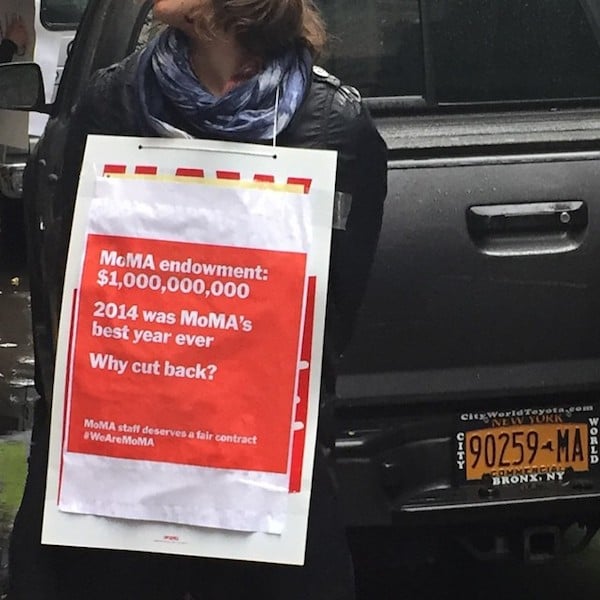
A protester sports a sign at the protest in front of MoMA
Photo: @tatsmarooh Instagram
Are there other issues?
The wage offer is pretty slim. We asked for six percent increases for everybody, or $3,000 flat, whichever is greater. For our lowest paid employees, who earn $30,000, a $3,000 amount would be a 10 percent increase.
They came back with their offer: For the lowest paid people, three percent or $2,500, whichever is greater, and a 1.5 percent increase thereafter for two years. The higher paid people would start out with 1.5 percent raises, and then keep rising at 1.5 percent for the next three.
They moved off that. They have come up a bit. They even came up in the dollar amount.
I should also mention that there’s also a whole bunch of stuff we put on the table about family benefits and childcare subsidies. We wanted improvement in maternity leave. About 75 percent of our bargaining unit is women; that’s important.
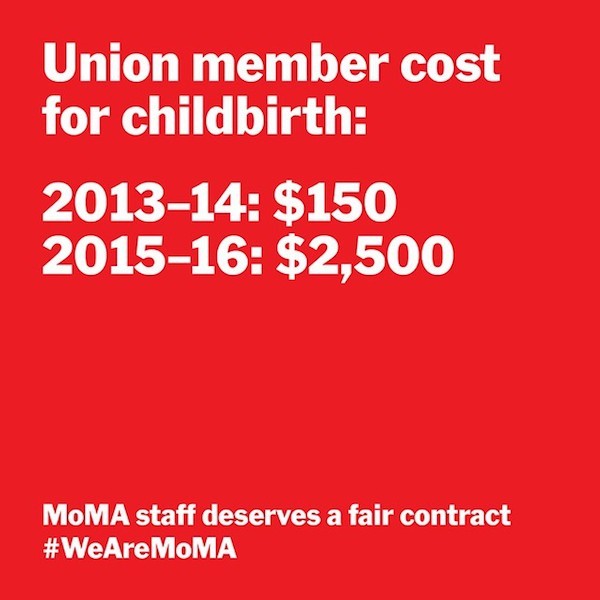
Meme from Local 2110’s #WeAreMoMA campaign
How long have negotiations been going on?
We started in the second week of May. We met once, and then the week after that we met again. Now, the meetings are coming one after another: We met yesterday, and we meet tomorrow.
Clearly they knew we were going to have a demonstration today, so they began to move. They made some tweaks in the plan design. They reduced the deductible, and they reduced the out-of-pocket limits to make it more affordable.
I don’t doubt that there is good will. They may not understand what this means to us. The outrage about this within the bargaining unit was just remarkable. And we are putting a voice to that outrage by being on the street tonight.
This is the regular contract negotiation that comes up every few years?
We happen to have had a long stretch since the last one, five years. They really want a three-year contract now. That’s negotiable. If they give us a good wage offer, we’d be willing to settle for three.
Why decide to protest now?
This is a major public event that the museum is putting on. So a protest will draw attention, and put a kind of public pressure on the museum. MoMA is a public institution, so the public should know.
There’s actually somewhat of a venerable tradition here at MoMA of our union being on the streets. Years ago it happened routinely. We had a four-and-a-half month strike in 2000, in which we pretty much won what we wanted. But it was a bitter fight, and no one wanted to go back to the pain and suffering of that on either side. So, after that we had two very good wage contracts.
For the last 15 years we have had labor peace here. This is not labor strife yet. I do think they are willing to work with us, and we with them. This protest is us expressing our collective outrage at what we have on the table.
They are not going to just believe those of us on the negotiating committee, because they know that we’re going to be the quote-unquote activists, and push for the best we can get. But if we get masses of people in the next few hours, that speaks louder than words.
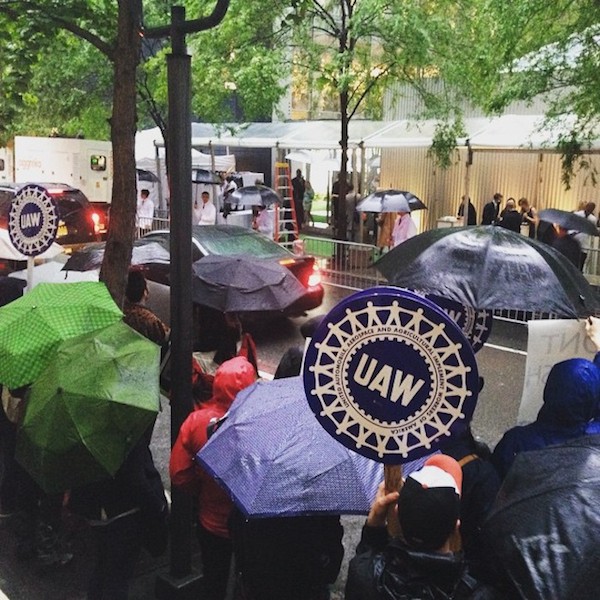
Protesters face the guests entering MoMA’s Party in the Garden
Photo: @ellenmoody Instagram
This is the first action tonight. Is the idea to do more actions?
They made changes quickly yesterday. We think it is because they were trying to fend of the possibility of this demonstration. But the changes weren’t enough, and they came too late in the day. So we’ll see how they are going to be at the table tomorrow morning, or if they are just going to pretend that nothing happened. But the line in the sand is drawn.
So, more actions as necessary?
Basically. And that would mean, as is our right, up to and including a strike.
I should emphasize, we’re trying to avert a strike. It is our right to strike, but we are trying to avert one. We are not going into this for the purpose of a strike, which would be punitive to ourselves and the institution. We don’t want to do that.
We think that they have a big enough heart to understand us once they believe us. It may take two or three actions, or more. We’ll see.
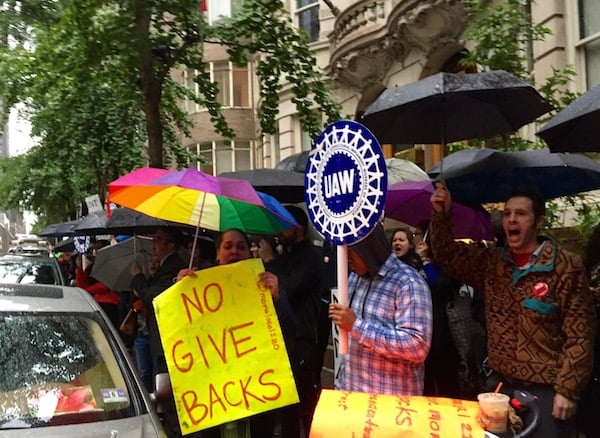
Protestors in front of MoMA
Photo: Ben Davis